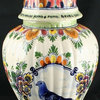
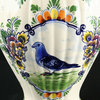
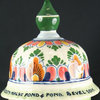
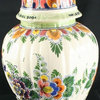
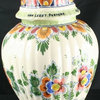
Item 1 of 5







Item 1 of 5


- Product Description
- Product Specifications
- Shipping and Returns
Product Details
- Item #: 5-106-0
- Dimensions (inches): 17H x 8.50W x 8.50D
- Comment: This vintage Polychrome Delft ginger jar vase is truly a conversation piece you will be proud to own! The hand-painted design ffeatures a multi-colored pigeon surrounded by flowers and was given to the Belgian National Pigeon Racing Champion, Van Leest-Peeters, to celebrate his pigeon racing victories in 2001! 2001 was actually the year that started it all, as Van Leest-Peters' winning pigeon, Bobby, was named the Golden Dove of Belgium and launched his award-winning career. Bring this highly unusual and rare hand-painted Polychrome Delft ginger jar home today and it may just be the inspiration you need to start racing pigeons!
- Origin: Holland
- Date: 2001
- Material: CERAMIC
- The word ceramic originates from the ancient Greek word keramikos, meaning potteres clay. The practice of making ceramics has been in existence for nearly 30,000 years. Clay, the primary ingredient for any ceramic, is primarily made of aluminum silicate, which is a malleable soil from crumbling rocks. Ceramics can be grouped according to the type of clay used, the temperature at which the clay is fired, and the duration of the firing.
- Availability: Available for Immediate Shipment.
- Condition
- Condition: GOOD
- In overall good condition. Antique and vintage items by their very nature show normal wear to finish and miscellaneous scratches, nicks, and dings due to age and use. As we define 'good condition' relative to the stated age of the piece, we would expect to see 'character marks' consistent with that age and could include nicks or dings to a wooden, metal, enamel, or chalkware object, wear to a painted surface, speckling on a mirror, crazing, wear to gilding, or manufacturing glaze skips in ceramic finish, wear to a label, and some original decorative trim may be missing. If ceramic/porcelain restoration has been done, it is of museum-quality so that it is hardly discernible and would be specifically mentioned in the listing. 'Good condition' could include very small fleabite chips or very small hairline cracks in any glass, ceramic, or marble item, but these would be specifically mentioned in the listing.
- Item Specifics: Shows crazing to the finish due to age and use.
- Shipping
- This Item Ships Free within the Contiguous 48 United States and this item will be shipped via a Ground shipping service (UPS or FedEx), approximate 1-6 business day shipping time. EuroLux may ship some packages via USPS Parcel Post, approximately 2-9 business day delivery time, at its sole discretion. All shipments include insurance.
Additional Information
- Mark: EuroLux Home
- Style: Delft DELFTWARE
- The European craze for blue and white Chinese export porcelain in the 17th century lead to the development of the Dutch East India Company, which imported millions of pieces of Chinese porcelain as well as other Chinese wares. In 1620, the death of Wan-Li (Ming Dynasty) interrupted the flow of goods to Europe. Dutch potters from the city of Delft quickly filled the gap in the market with their own production of blue and white ceramics that duplicated the look of Chinese export porcelain by using the tin-glazing technique learned from the Italians. The Delft potters were the first northerners to imitate the tin-glazed earthenware pottery of Italian majolica, or faience. Production of Delftware proliferated and by 1700 there were more than 30 factories in production of high-quality pieces in the city of Delft.
- Delftware drew on Chinese designs for inspiration, but also developed European patterns. Decorative plates were made in abundance and featured native Dutch scenes with windmills and fishing boats, hunting scenes, landscapes, seascapes, and scenes of people in daily life. When Chinese exports re-entered the European market by 1685, they came back in color, especially in greens and pinks. This sparked the production of Polychrome Delft, which refers to the use of colors other than blue and white. Besides the popular cobalt blue on a white background, Delft potters had a full color range that consisted of yellow, orange, brown, green, purple, dark red, and black.
- Despite the huge success of Delftware manufacturers, the market for Delftware eroded through the 18th century until eventually only one factory in Delft remained in existence. Joost Thooft bought the last remaining Delftware factory, De Porceleyne Fles, in 1876. Since that time, over one hundred potteries have come back into existence producing what is known as modern Delftware, which no longer uses the tin glazing method of majolica.
- In the period from 1876 to 1940, many high-quality, beautiful pieces of Delftware were produced. The transfer printing process was also brought back at this time. After World War II, tourism began to play a larger role in the Dutch economy. More Delftware companies opened in the 1950s to 1970s, specializing in pieces made for the tourist trade. Delftware has been produced in Holland, Belgium, Germany, England, Japan, and the US, and is still in production today.
- Object: Vase
Consigned Vintage Hand-Painted Polychrome Delft Ginger
Product Details
- Item #: 5-106-0
- Dimensions (inches): 17H x 8.50W x 8.50D
- Comment: This vintage Polychrome Delft ginger jar vase is truly a conversation piece you will be proud to own! The hand-painted design ffeatures a multi-colored pigeon surrounded by flowers and was given to the Belgian National Pigeon Racing Champion, Van Leest-Peeters, to celebrate his pigeon racing victories in 2001! 2001 was actually the year that started it all, as Van Leest-Peters' winning pigeon, Bobby, was named the Golden Dove of Belgium and launched his award-winning career. Bring this highly unusual and rare hand-painted Polychrome Delft ginger jar home today and it may just be the inspiration you need to start racing pigeons!
- Origin: Holland
- Date: 2001
- Material: CERAMIC
- The word ceramic originates from the ancient Greek word keramikos, meaning potteres clay. The practice of making ceramics has been in existence for nearly 30,000 years. Clay, the primary ingredient for any ceramic, is primarily made of aluminum silicate, which is a malleable soil from crumbling rocks. Ceramics can be grouped according to the type of clay used, the temperature at which the clay is fired, and the duration of the firing.
- Availability: Available for Immediate Shipment.
- Condition
- Condition: GOOD
- In overall good condition. Antique and vintage items by their very nature show normal wear to finish and miscellaneous scratches, nicks, and dings due to age and use. As we define 'good condition' relative to the stated age of the piece, we would expect to see 'character marks' consistent with that age and could include nicks or dings to a wooden, metal, enamel, or chalkware object, wear to a painted surface, speckling on a mirror, crazing, wear to gilding, or manufacturing glaze skips in ceramic finish, wear to a label, and some original decorative trim may be missing. If ceramic/porcelain restoration has been done, it is of museum-quality so that it is hardly discernible and would be specifically mentioned in the listing. 'Good condition' could include very small fleabite chips or very small hairline cracks in any glass, ceramic, or marble item, but these would be specifically mentioned in the listing.
- Item Specifics: Shows crazing to the finish due to age and use.
- Shipping
- This Item Ships Free within the Contiguous 48 United States and this item will be shipped via a Ground shipping service (UPS or FedEx), approximate 1-6 business day shipping time. EuroLux may ship some packages via USPS Parcel Post, approximately 2-9 business day delivery time, at its sole discretion. All shipments include insurance.
Additional Information
- Mark: EuroLux Home
- Style: Delft DELFTWARE
- The European craze for blue and white Chinese export porcelain in the 17th century lead to the development of the Dutch East India Company, which imported millions of pieces of Chinese porcelain as well as other Chinese wares. In 1620, the death of Wan-Li (Ming Dynasty) interrupted the flow of goods to Europe. Dutch potters from the city of Delft quickly filled the gap in the market with their own production of blue and white ceramics that duplicated the look of Chinese export porcelain by using the tin-glazing technique learned from the Italians. The Delft potters were the first northerners to imitate the tin-glazed earthenware pottery of Italian majolica, or faience. Production of Delftware proliferated and by 1700 there were more than 30 factories in production of high-quality pieces in the city of Delft.
- Delftware drew on Chinese designs for inspiration, but also developed European patterns. Decorative plates were made in abundance and featured native Dutch scenes with windmills and fishing boats, hunting scenes, landscapes, seascapes, and scenes of people in daily life. When Chinese exports re-entered the European market by 1685, they came back in color, especially in greens and pinks. This sparked the production of Polychrome Delft, which refers to the use of colors other than blue and white. Besides the popular cobalt blue on a white background, Delft potters had a full color range that consisted of yellow, orange, brown, green, purple, dark red, and black.
- Despite the huge success of Delftware manufacturers, the market for Delftware eroded through the 18th century until eventually only one factory in Delft remained in existence. Joost Thooft bought the last remaining Delftware factory, De Porceleyne Fles, in 1876. Since that time, over one hundred potteries have come back into existence producing what is known as modern Delftware, which no longer uses the tin glazing method of majolica.
- In the period from 1876 to 1940, many high-quality, beautiful pieces of Delftware were produced. The transfer printing process was also brought back at this time. After World War II, tourism began to play a larger role in the Dutch economy. More Delftware companies opened in the 1950s to 1970s, specializing in pieces made for the tourist trade. Delftware has been produced in Holland, Belgium, Germany, England, Japan, and the US, and is still in production today.
- Object: Vase
- Product ID
- 12653769
- Sold By
- EuroLuxHome
- Size
- W 8.5" / D 8.5" / H 17"
- Materials
- Ceramic
- Category
- Home Decor
- Style
- Traditional
- Product Description
- Product Specifications
- Shipping and Returns
Product Details
- Item #: 5-106-0
- Dimensions (inches): 17H x 8.50W x 8.50D
- Comment: This vintage Polychrome Delft ginger jar vase is truly a conversation piece you will be proud to own! The hand-painted design ffeatures a multi-colored pigeon surrounded by flowers and was given to the Belgian National Pigeon Racing Champion, Van Leest-Peeters, to celebrate his pigeon racing victories in 2001! 2001 was actually the year that started it all, as Van Leest-Peters' winning pigeon, Bobby, was named the Golden Dove of Belgium and launched his award-winning career. Bring this highly unusual and rare hand-painted Polychrome Delft ginger jar home today and it may just be the inspiration you need to start racing pigeons!
- Origin: Holland
- Date: 2001
- Material: CERAMIC
- The word ceramic originates from the ancient Greek word keramikos, meaning potteres clay. The practice of making ceramics has been in existence for nearly 30,000 years. Clay, the primary ingredient for any ceramic, is primarily made of aluminum silicate, which is a malleable soil from crumbling rocks. Ceramics can be grouped according to the type of clay used, the temperature at which the clay is fired, and the duration of the firing.
- Availability: Available for Immediate Shipment.
- Condition
- Condition: GOOD
- In overall good condition. Antique and vintage items by their very nature show normal wear to finish and miscellaneous scratches, nicks, and dings due to age and use. As we define 'good condition' relative to the stated age of the piece, we would expect to see 'character marks' consistent with that age and could include nicks or dings to a wooden, metal, enamel, or chalkware object, wear to a painted surface, speckling on a mirror, crazing, wear to gilding, or manufacturing glaze skips in ceramic finish, wear to a label, and some original decorative trim may be missing. If ceramic/porcelain restoration has been done, it is of museum-quality so that it is hardly discernible and would be specifically mentioned in the listing. 'Good condition' could include very small fleabite chips or very small hairline cracks in any glass, ceramic, or marble item, but these would be specifically mentioned in the listing.
- Item Specifics: Shows crazing to the finish due to age and use.
- Shipping
- This Item Ships Free within the Contiguous 48 United States and this item will be shipped via a Ground shipping service (UPS or FedEx), approximate 1-6 business day shipping time. EuroLux may ship some packages via USPS Parcel Post, approximately 2-9 business day delivery time, at its sole discretion. All shipments include insurance.
Additional Information
- Mark: EuroLux Home
- Style: Delft DELFTWARE
- The European craze for blue and white Chinese export porcelain in the 17th century lead to the development of the Dutch East India Company, which imported millions of pieces of Chinese porcelain as well as other Chinese wares. In 1620, the death of Wan-Li (Ming Dynasty) interrupted the flow of goods to Europe. Dutch potters from the city of Delft quickly filled the gap in the market with their own production of blue and white ceramics that duplicated the look of Chinese export porcelain by using the tin-glazing technique learned from the Italians. The Delft potters were the first northerners to imitate the tin-glazed earthenware pottery of Italian majolica, or faience. Production of Delftware proliferated and by 1700 there were more than 30 factories in production of high-quality pieces in the city of Delft.
- Delftware drew on Chinese designs for inspiration, but also developed European patterns. Decorative plates were made in abundance and featured native Dutch scenes with windmills and fishing boats, hunting scenes, landscapes, seascapes, and scenes of people in daily life. When Chinese exports re-entered the European market by 1685, they came back in color, especially in greens and pinks. This sparked the production of Polychrome Delft, which refers to the use of colors other than blue and white. Besides the popular cobalt blue on a white background, Delft potters had a full color range that consisted of yellow, orange, brown, green, purple, dark red, and black.
- Despite the huge success of Delftware manufacturers, the market for Delftware eroded through the 18th century until eventually only one factory in Delft remained in existence. Joost Thooft bought the last remaining Delftware factory, De Porceleyne Fles, in 1876. Since that time, over one hundred potteries have come back into existence producing what is known as modern Delftware, which no longer uses the tin glazing method of majolica.
- In the period from 1876 to 1940, many high-quality, beautiful pieces of Delftware were produced. The transfer printing process was also brought back at this time. After World War II, tourism began to play a larger role in the Dutch economy. More Delftware companies opened in the 1950s to 1970s, specializing in pieces made for the tourist trade. Delftware has been produced in Holland, Belgium, Germany, England, Japan, and the US, and is still in production today.
- Object: Vase
At Houzz we want you to shop for Consigned Vintage Hand-Painted Polychrome Delft Ginger with confidence. You can read real customer reviews for this or any other product and even ask questions and get answers from us or straight from the brand. When you buy Consigned Vintage Hand-Painted Polychrome Delft Ginger or any product product online from us, you become part of the Houzz family and can expect exceptional customer service every step of the way. If you have questions about or any other product for sale, our customer service team is eager to help.
Browse over 25 million home design photos on Houzz






